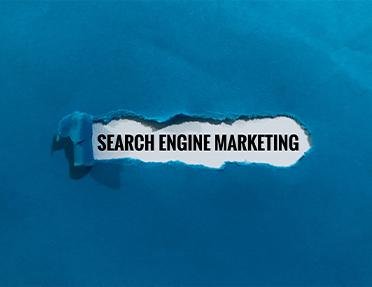
SEM | Search Engine Marketing
Our digital marketing strategy that focuses on increasing a website's visibility on search engine results pages (SERPs) through paid advertising. SEM helps businesses reach potential customers by placing ads in front of users who are actively searching for specific products, services, or information.

Here are the key components of SEO services:
- Pay-Per-Click (PPC) Advertising
- Keyword Research and Targeting
- Ad Copywriting and Optimization
- Landing Page Optimization
- Ad Auction and Bidding Strategies
- Retargeting and Remarketing
- Performance Tracking and Analytics
- Campaign Management
- Local Search Ads
- Video and YouTube Ads
- Shopping Ads for eCommerce
- Mobile Search Ads
- Display Advertising
- Competitor Analysis
- Google Ads Extensions
- International Search Ads
1. Pay-Per-Click (PPC) Advertising
- Google Ads: Running ads on Google’s search network and display network, allowing businesses to target keywords relevant to their products or services.
- Bing Ads: Similar to Google Ads but focused on Bing’s search engine and its partner sites.
- Search Ad Campaigns: Creating text ads that appear at the top of search results when users search for targeted keywords.
- Display Ads: Designing visual banner ads that are displayed on Google’s partner sites (Display Network).
- Shopping Ads: Running product ads for eCommerce sites, displaying product images, pricing, and store details in the SERPs.
2. Keyword Research and Targeting
- Keyword Selection: Choosing the right keywords to bid on, based on relevance, search volume, and competition.
- Negative Keywords: Excluding specific keywords to avoid irrelevant traffic and reduce ad spend.
- Long-Tail Keywords: Targeting specific, lower-competition phrases to attract niche audiences.
- Geo-Targeting: Using location-specific keywords to target users in a certain geographical area.
3. Ad Copywriting and Optimization
- Compelling Headlines: Writing attention-grabbing headlines that encourage users to click on the ad.
- Ad Extensions: Adding extra information to ads such as site links, phone numbers, or location to increase click-through rates (CTR).
- A/B Testing: Creating multiple versions of ads to determine which performs best and continually optimizing ad copy for better results.
- Call-to-Action (CTA): Including clear and persuasive CTAs to drive conversions, such as "Buy Now" or "Sign Up Today."
4. Landing Page Optimization
- Dedicated Landing Pages: Creating specific landing pages that match the intent of the ad and provide a seamless user experience.
- Conversion Rate Optimization (CRO): Implementing strategies to maximize conversions on landing pages, such as simplifying forms or improving page speed.
- Relevant Content: Ensuring that the content on the landing page aligns with the ad copy and delivers on the promise made in the ad.
5. Ad Auction and Bidding Strategies
- Manual Bidding: Setting bids manually for specific keywords, giving businesses control over how much they pay per click.
- Automated Bidding: Using automated tools to adjust bids based on performance metrics, audience behavior, and other factors.
- Cost-Per-Click (CPC): Paying for each click on the ad, with the cost determined by the competition for the targeted keywords.
- Cost-Per-Thousand Impressions (CPM): Paying based on the number of times the ad is shown, regardless of clicks (usually for display ads).
- Cost-Per-Acquisition (CPA): Optimizing bids based on the desired cost for acquiring a conversion, such as a purchase or sign-up.
6. Retargeting and Remarketing
- Retargeting Campaigns: Displaying ads to users who have previously visited your website or engaged with your content but did not convert.
- Custom Audiences: Building audiences based on previous website interactions, including users who viewed specific products or pages.
- Dynamic Remarketing: Showing ads with personalized product recommendations based on users’ past behavior on your site.
7. Performance Tracking and Analytics
- Conversion Tracking: Measuring key performance indicators (KPIs) like clicks, conversions, sales, and return on ad spend (ROAS).
- Click-Through Rate (CTR) Monitoring: Tracking how often your ads are clicked in relation to how often they are shown, and adjusting strategies to improve CTR.
- Quality Score: Monitoring Google’s Quality Score, which influences ad position and cost, based on the relevance of keywords, ads, and landing pages.
- Campaign Reporting: Generating regular reports to assess the effectiveness of campaigns and making data-driven decisions for future optimizations.
8. Campaign Management
- Ongoing Optimization: Continuously optimizing campaigns by refining keywords, adjusting bids, improving ad copy, and enhancing landing pages.
- Budget Management: Allocating budgets efficiently to maximize ROI while controlling ad spend.
- Seasonal Adjustments: Modifying bids, keywords, and ads to capitalize on seasonal trends or special promotions.
9. Local Search Ads
- Local Business Ads: Creating ads that appear in local searches for specific geographic areas.
- Google Maps Integration: Running ads on Google Maps to target users searching for nearby businesses.
- Location Extensions: Displaying business addresses, phone numbers, and directions in search ads for better visibility in local searches.
10. Video and YouTube Ads
- Video Ad Campaigns: Running ads on YouTube and other video platforms, targeting users based on interests, demographics, and search behavior.
- In-Stream Ads: Placing skippable and non-skippable ads before, during, or after videos on YouTube.
- Video Discovery Ads: Promoting videos in YouTube search results, helping users discover your brand or products through engaging content.
11. Shopping Ads for eCommerce
- Product Listing Ads (PLAs): Running ads that show images, prices, and details for eCommerce products directly in search results.
- Google Merchant Center Integration: Connecting eCommerce websites to Google Merchant Center for easy management of product data for shopping ads.
- Shopping Campaign Management: Organizing products into ad groups, setting bids, and optimizing ad performance for online stores.
12. Mobile Search Ads
- Mobile-Optimized Ads: Designing and managing ads specifically tailored for mobile users to improve engagement and conversion rates.
- App Install Ads: Running campaigns that drive app installs directly from search results.
- Click-to-Call Ads: Creating ads with call buttons, allowing mobile users to directly contact businesses without visiting the website.
13. Display Advertising
- Banner Ads: Running visual ads on Google’s Display Network, which includes millions of partner websites and apps.
- Responsive Ads: Designing responsive ads that automatically adjust to different screen sizes and formats.
- Contextual Targeting: Showing ads on relevant websites based on the content or topics covered on the page.
14. Competitor Analysis
- Ad Intelligence: Analyzing competitors' ad strategies, keyword usage, and bidding strategies.
- Benchmarking: Comparing performance against competitors to find gaps and opportunities in the market.
15. Google Ads Extensions
- Callout Extensions: Highlighting special offers or unique selling points directly in the ad copy.
- Call Extensions: Adding phone numbers to ads for easy customer contact.
- Sitelink Extensions: Providing additional links in the ad to specific pages on the website, enhancing user experience.
16. International Search Ads
- Multilingual Campaigns: Creating and managing search ad campaigns in different languages to reach global audiences.
- Geo-Targeting for Global Markets: Adjusting ad bids and targeting by country or region for international campaigns.
Our SEM strategies can help businesses drive targeted traffic, enhance visibility, and achieve measurable results through paid search campaigns. SEM combines the immediacy of paid ads with precise audience targeting, making it a valuable component of a comprehensive digital marketing strategy.
